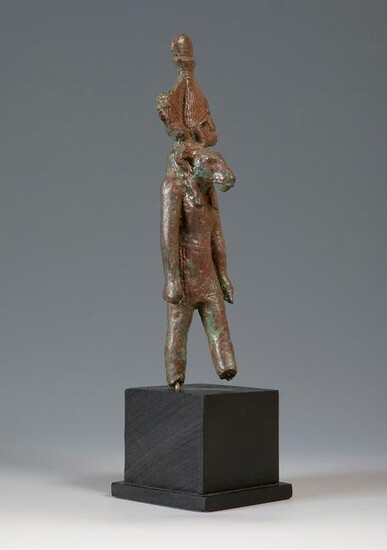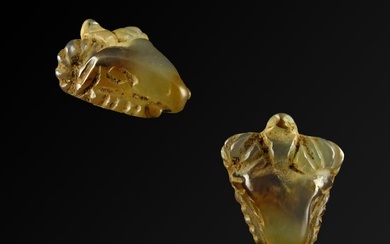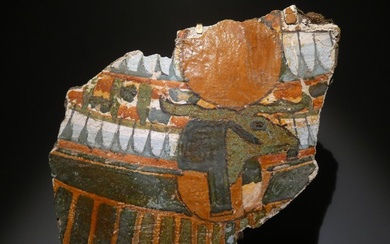God Khnum; Ancient Egypt, Late Period, 664 – 323 BC.
God Jnum; Ancient Egypt, Late Antiquity, 664 - 323 BC.
Bronze.
It is in a generally good state of preservation. The legs are missing at the level of half a tibia and a fragment of the crown.
Provenance: Private collection, Spain.
Measurements: 16.5 cm in height.
Sculptural work, made in solid lost wax bronze, of one of the main deities of the Egyptian pantheon, the god Jnum, or Khnum. He has the appearance of a man with a ram's head and wavy horns, carrying a double crown or a water jug on his head. He is one of the oldest gods. He was the creator god of Elephantine. In Esna he was believed to have fashioned the primordial egg from which the sun rose at the beginning of the world. He was originally a god of water, the guardian of the sources of the Nile, which for the Egyptians was the same as guarding the source of life; or of the flood of the Nile and, as such, he was depicted with water flowing from his hands and carrying a pitcher on his head and was given the title "Lord of the waterfall" and the name Qebh. He was also the guardian god of the waters of the nether world and bears the title "The Lord of the Beyond". He was the potter god who moulded the person, creating at the same time his ka, at the moment of his birth, so he was called "The Father of Fathers and the Mother of Mothers". His name literally means "the moulder". Jnum built the material universe together with Ptah and under the guidance and direction of Thoth. According to a legend, Jnum originally created each man on his potter's wheel, but at one point, tired of spinning and spinning, he broke his wheel and placed a part of it in each female, so that from then on all things could reproduce without his intervention. He was part of the triad of Esna, together with Satis and Neith, and of the triad of Elephantine, as husband of Satis and father of Anukis, although in the Late Epoch it was Neith and Heka who formed a triad with him. He had various forms: Jnum Nehep (the creator), Jnum Jenti-Taui (the ruler of the two lands), Jnum Sejet ashsep-f (he who weaves his light), Jnum Jenti per-anj (ruler of the House of Life), Jnum Neb-ta-anjtet (Lord of the Land of Life), Jnum Jenti netchemtchem anjet (Ruler of the House of Sweet Life), Jnum Neb (Lord). He is often identified with Amun, as Amun Jnum Jnum, to whom the Greeks gave the name Zeus Ammon and the Romans Jupiter Ammon. His main sanctuaries were at Esna and Elephantine, as he was the god of the sources of the Nile. He was also worshipped at Hypselis, Antinoe and Phyle.
Jnum is one of the few gods of the Egyptian pantheon who was assimilated into the most important theories of creation. Not only does he appear in a creative role in the Memphite theory, but he is also related to the solar theories of Heliopolis, which is why, in addition to Ptah, he is associated with Ra and is even closely related to Amun, thus participating in Theban theology.
This piece was made using the lost-wax technique, a sculptural procedure in which a mould is first made from a prototype, traditionally carved in beeswax. The preliminary model is surrounded by a thick layer of soft material that solidifies, usually clay; once hardened, it is placed inside a furnace, which melts the wax figure, which comes out through specially created holes, and in its place molten metal is injected to take the exact shape of the model. To remove the final piece, the mould must be removed.
Estimate
Time, Location
Auction House
God Jnum; Ancient Egypt, Late Antiquity, 664 - 323 BC.
Bronze.
It is in a generally good state of preservation. The legs are missing at the level of half a tibia and a fragment of the crown.
Provenance: Private collection, Spain.
Measurements: 16.5 cm in height.
Sculptural work, made in solid lost wax bronze, of one of the main deities of the Egyptian pantheon, the god Jnum, or Khnum. He has the appearance of a man with a ram's head and wavy horns, carrying a double crown or a water jug on his head. He is one of the oldest gods. He was the creator god of Elephantine. In Esna he was believed to have fashioned the primordial egg from which the sun rose at the beginning of the world. He was originally a god of water, the guardian of the sources of the Nile, which for the Egyptians was the same as guarding the source of life; or of the flood of the Nile and, as such, he was depicted with water flowing from his hands and carrying a pitcher on his head and was given the title "Lord of the waterfall" and the name Qebh. He was also the guardian god of the waters of the nether world and bears the title "The Lord of the Beyond". He was the potter god who moulded the person, creating at the same time his ka, at the moment of his birth, so he was called "The Father of Fathers and the Mother of Mothers". His name literally means "the moulder". Jnum built the material universe together with Ptah and under the guidance and direction of Thoth. According to a legend, Jnum originally created each man on his potter's wheel, but at one point, tired of spinning and spinning, he broke his wheel and placed a part of it in each female, so that from then on all things could reproduce without his intervention. He was part of the triad of Esna, together with Satis and Neith, and of the triad of Elephantine, as husband of Satis and father of Anukis, although in the Late Epoch it was Neith and Heka who formed a triad with him. He had various forms: Jnum Nehep (the creator), Jnum Jenti-Taui (the ruler of the two lands), Jnum Sejet ashsep-f (he who weaves his light), Jnum Jenti per-anj (ruler of the House of Life), Jnum Neb-ta-anjtet (Lord of the Land of Life), Jnum Jenti netchemtchem anjet (Ruler of the House of Sweet Life), Jnum Neb (Lord). He is often identified with Amun, as Amun Jnum Jnum, to whom the Greeks gave the name Zeus Ammon and the Romans Jupiter Ammon. His main sanctuaries were at Esna and Elephantine, as he was the god of the sources of the Nile. He was also worshipped at Hypselis, Antinoe and Phyle.
Jnum is one of the few gods of the Egyptian pantheon who was assimilated into the most important theories of creation. Not only does he appear in a creative role in the Memphite theory, but he is also related to the solar theories of Heliopolis, which is why, in addition to Ptah, he is associated with Ra and is even closely related to Amun, thus participating in Theban theology.
This piece was made using the lost-wax technique, a sculptural procedure in which a mould is first made from a prototype, traditionally carved in beeswax. The preliminary model is surrounded by a thick layer of soft material that solidifies, usually clay; once hardened, it is placed inside a furnace, which melts the wax figure, which comes out through specially created holes, and in its place molten metal is injected to take the exact shape of the model. To remove the final piece, the mould must be removed.






